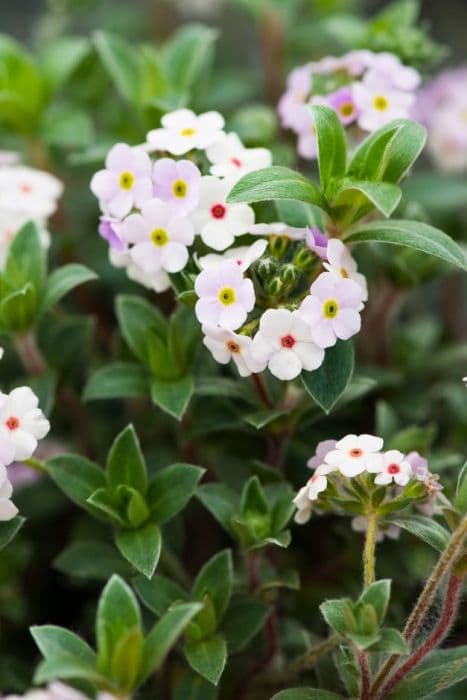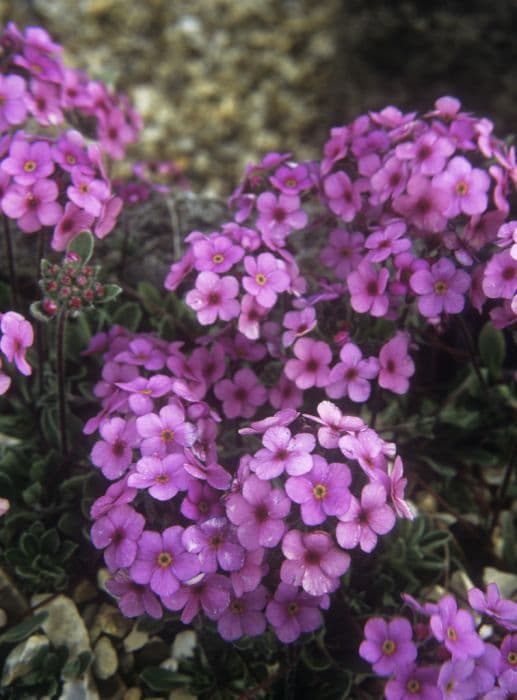Forster's Primrose Primula × forsteri 'Bileckii' (Au)

ABOUT
Primula × forsteri 'Bileckii' (Au), commonly known as the primrose, is a hybrid ornamental plant. The primrose is cherished for its attractive flowers, which grace gardens with a vibrancy of colors. The blooms are typically arranged in a cluster, with each individual flower possessing a rounded shape. The petals of the primrose are often found in a spectrum of hues, ranging from soft pastels to bright, eye-catching shades. The center of each flower tends to have a contrasting hue, creating a striking focal point. The foliage of the primrose forms a lush rosette at the base of the stems. The leaves are usually oval-shaped with a slightly wavy or toothed margin, exuding a shade of green that complements the vivid colors of the flowers. The leaves may feel soft to the touch with a velvety texture. Together, the blooms and foliage of the primrose present a delightful and colorful display, making it a popular choice for gardeners seeking to add a touch of charm to their flower beds or borders.
About this plant
 Names
NamesSynonyms
No common names available.
Common names
Primula × forsteri 'Bileckii' (Au).
 Toxicity
ToxicityTo humans
Primroses, including the hybrid Primula × forsteri 'Bileckii', are generally considered non-toxic to humans. While they are not known for being poisonous, it's important to note that some people may have sensitivity to primroses which could lead to mild irritation or an allergic reaction when the plant is handled or ingested. This can result in symptoms such as nausea, vomiting, or diarrhea in rare cases. Care should always be taken when handling or ingesting plants, and primroses are no exception, even though they are not commonly associated with severe toxicity in humans.
To pets
Primroses, including the hybrid Primula × forsteri 'Bileckii', are considered to have mild toxicity for pets. However, ingestion can lead to mild gastrointestinal upset, resulting in symptoms such as vomiting or diarrhea. If a pet consumes a significant amount of the plant, or if they are particularly sensitive, they may show more pronounced signs of distress. Consulting a veterinarian is advisable if any abnormal signs are noticed after a pet has ingested parts of a primrose.
 Characteristics
CharacteristicsLife cycle
Perennials
Foliage type
Semi-deciduous
Color of leaves
Green
Flower color
Varies
Height
6 inches (15 cm)
Spread
12 inches (30 cm)
Plant type
Herb
Hardiness zones
Varies
Native area
Cultivar
Benefits
 General Benefits
General Benefits- Ornamental Value: Primula × forsteri 'Bileckii', commonly known as Forster's Primrose, is valued for its colorful flowers, adding aesthetic appeal to gardens and landscapes.
- Pollinator Attraction: The plant's flowers can attract bees, butterflies, and other pollinating insects, supporting local biodiversity.
- Easy Cultivation: Forster's Primrose is known for being relatively easy to grow in a variety of conditions, making it suitable for amateur gardeners.
- Seasonal Interest: Blooming in early spring, it provides a splash of color when many other plants have yet to flower.
- Compact Size: With its small stature, it fits well in smaller gardens or as an underplanting in larger landscape designs.
- Variety of Uses: It can be used in border plantings, rock gardens, container gardening, and as ground cover.
- Mood Enhancement: The bright and cheerful flowers of the Forster's Primrose can help to improve mood and create a serene environment.
 Medical Properties
Medical PropertiesThis plant is not used for medical purposes.
 Air-purifying Qualities
Air-purifying QualitiesThis plant is not specifically known for air purifying qualities.
 Other Uses
Other Uses- As a natural fabric dye: The petals of Polyanthus can be used to create a variety of hues for dyeing fabric, depending on the mordant used.
- In art and crafts: Dried flowers of the Polyanthus may be pressed and included in floral arrangements, scrapbooking, or decoupage projects.
- As a photography subject: With their vibrant colors and patterns, Polyanthus flowers are a popular choice for macro and nature photography.
- In educational settings: Polyanthus can be used to teach students about plant biology, hybridization, and the life cycle of perennial plants.
- As a natural pesticide: Some gardeners use Polyanthus as a companion plant to deter certain pests from more vulnerable plants.
- In eco-friendly confetti: Dried petals of Polyanthus can be used as biodegradable confetti for celebrations and weddings.
- For culinary decoration: Edible flowers of Polyanthus may adorn desserts and cocktails, although one must ensure they are free of pesticides and safe for consumption.
- As a natural ink: Similar to dye uses, the pigments from Polyanthus petals can be made into inks for writing and drawing.
- In potpourri: Dried Polyanthus flowers can add color and a mild fragrance to homemade potpourri mixes.
- In mindfulness and relaxation practices: Some people include caring for Polyanthus plants as part of their daily mindfulness or therapeutic horticulture routines.
Interesting Facts
 Feng Shui
Feng ShuiThe Primrose is not used in Feng Shui practice.
 Zodiac Sign Compitability
Zodiac Sign CompitabilityThe Primrose is not used in astrology practice.
 Plant Symbolism
Plant Symbolism- Hope: The Primula, commonly known as the primrose, often symbolizes hope due to its association with the early spring season, bringing with it the first signs of life after a cold winter.
- Renewal: As the primrose is one of the first flowers to bloom, it represents the idea of new beginnings and rejuvenation.
- Youth: The delicate and fresh appearance of primroses evokes the qualities of youth and innocence.
- Love: In the language of flowers, the primrose can be a symbol of young love or affection.
 Water
WaterPrimula 'Bileckii' should be watered when the top inch of soil feels dry to the touch, which usually means watering once or twice a week, depending on environmental conditions. Ensure the plant receives enough water to keep the soil evenly moist but not soggy, using roughly 16-24 ounces of water each time. During the active growing season in spring and summer, they may require more frequent watering, while in the colder months, water less frequently. It's crucial to have a pot with good drainage to prevent waterlogging, which can cause root rot.
 Light
LightPrimula 'Bileckii' thrives best in bright, indirect light. A north-facing window or a position that provides filtered sunlight is ideal to prevent the foliage from scorching. Avoid exposing the plant to harsh, direct afternoon sun, especially in hotter climates, as this can be detrimental to its growth and bloom.
 Temperature
TemperaturePrimula 'Bileckii' prefers cool to moderate temperatures, ideally between 60-75°F. They can survive minimum temperatures down to about 50°F and should not be exposed to temperatures above 80°F for prolonged periods. To ensure healthy growth, try keeping your 'Bileckii' in an environment that closely matches these ideal conditions.
 Pruning
PruningPrimula 'Bileckii' benefits from deadheading spent flowers to encourage more blooms and prevent the plant from wasting energy on seed production. Pruning should be done carefully with clean, sharp scissors or secateurs. The best time to prune is after flowering has finished, typically in late spring or early summer, which helps maintain a tidy appearance and promotes healthy growth for the following season.
 Cleaning
CleaningAs needed
 Soil
SoilThe ideal soil mix for Primula (Polyanthus) should be rich, well-draining, with plenty of organic matter, such as peat moss or compost. A mixture consisting of two parts peat, one part loam, and one part sand or perlite works well. The soil pH should be slightly acidic to neutral, ideally between 6.0 and 7.0.
 Repotting
RepottingPolyanthus should be repotted annually to replenish the soil and provide room for root growth. It's best to repot after the blooming period, as part of their post-bloom care routine.
 Humidity & Misting
Humidity & MistingPolyanthus thrives in moderate humidity levels around 40-50%. They benefit from a humid environment but do not tolerate excessively wet foliage or soil, so ensure good air circulation to prevent fungal diseases.
 Suitable locations
Suitable locationsIndoor
Provide bright light, cool temperature, moderate humidity.
Outdoor
Plant in partial shade, moist, well-drained soil.
Hardiness zone
5-9 USDA
 Life cycle
Life cyclePrimula × forsteri 'Bileckii', commonly referred to as Forster's Primrose, begins its life cycle with seed germination, typically occurring in a moist, well-draining soil environment during spring. Young seedlings emerge and grow into rosettes, developing a sturdy root system and foliage. The plant reaches maturity and enters the flowering stage in late winter to spring, producing clusters of colorful blooms that attract pollinators such as bees and butterflies. After pollination, seeds develop and are eventually dispersed to propagate the next generation. In the dormant period during summer or dry spells, the plant conserves energy and may die back, surviving through its hardy rootstock or seeds for the next season. With appropriate care, Forster's Primrose may also multiply through vegetative propagation, as offsets can be separated from the parent plant to start new individuals.
 Propogation
PropogationPropogation time
Spring-summer
The popular method for propagating Primula × forsteri 'Bileckii', commonly known as hybrid primrose, is by division. This method is typically carried out in late summer or early fall after the flowering period has ended. To propagate by division, the gardener should carefully lift the plant from the soil, making sure to keep a good amount of dirt around the roots. Then, using their hands or a sharp knife, the clump can be divided into smaller sections, ensuring that each new section has a healthy portion of roots and a few leaves. The divisions can then be replanted immediately into well-prepared soil, spaced about 6 to 12 inches apart, which is roughly 15 to 30 centimeters, to give each new plant enough space to grow. Consistent watering after planting is crucial for establishment. This technique allows for rapid increase of stock while maintaining the characteristics of the hybrid primrose.









